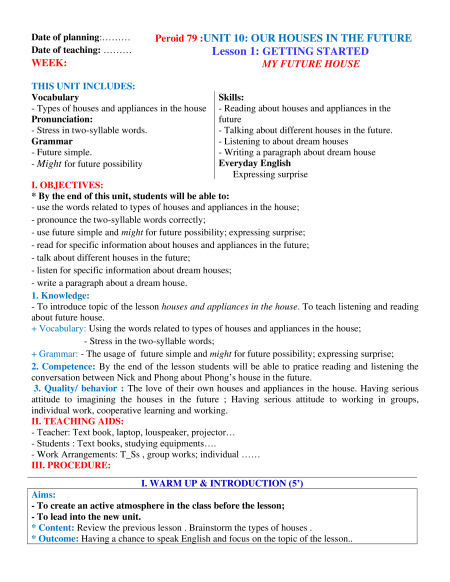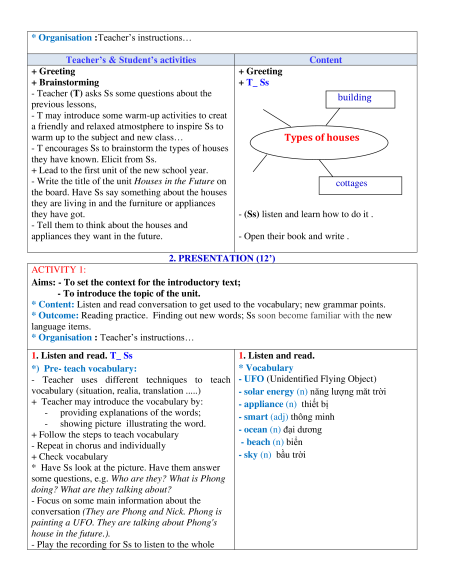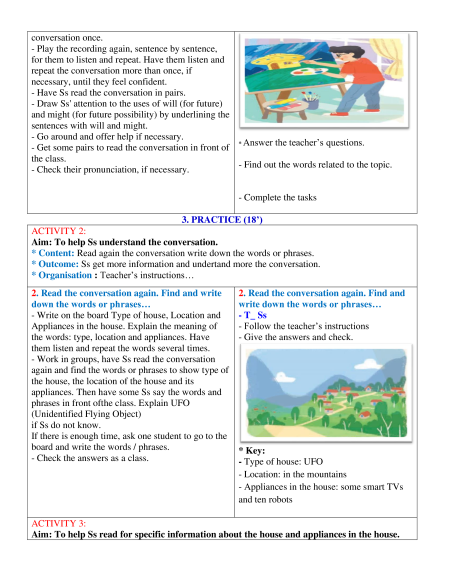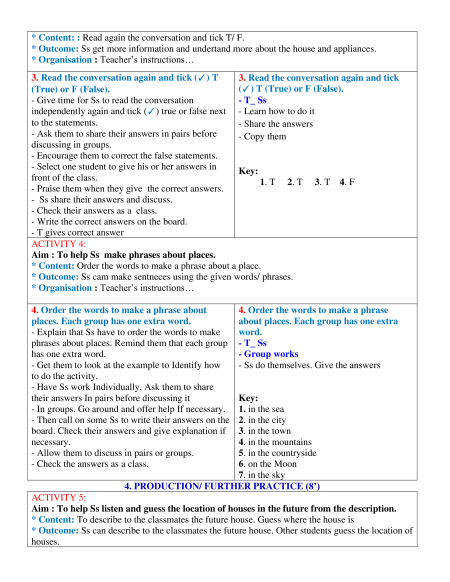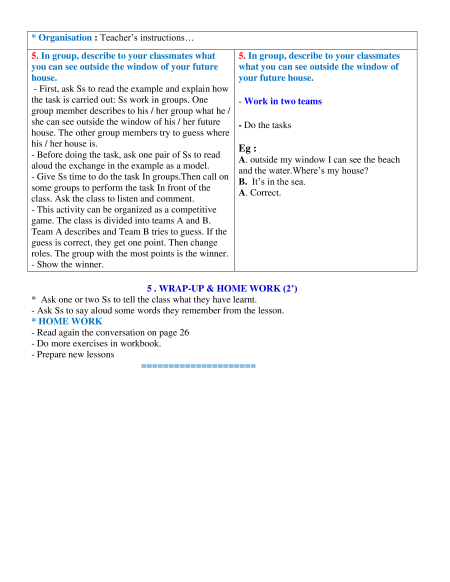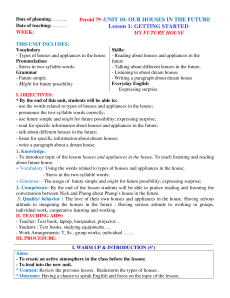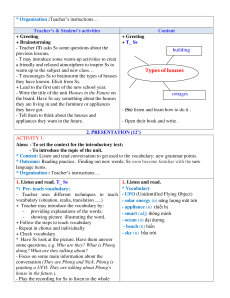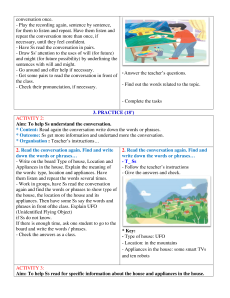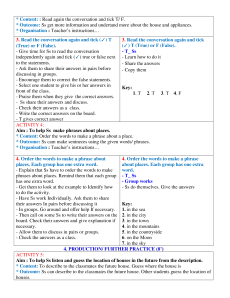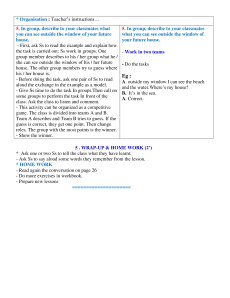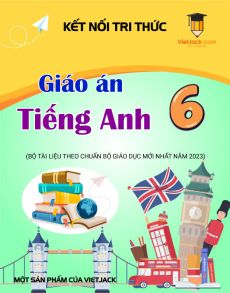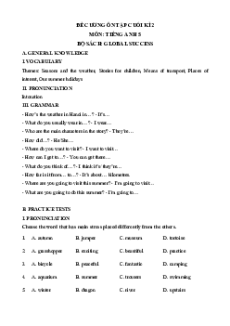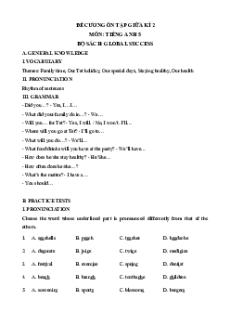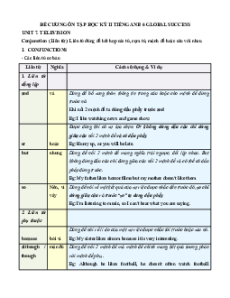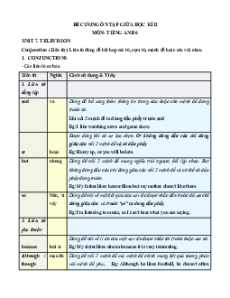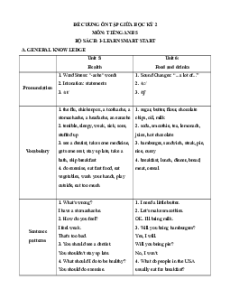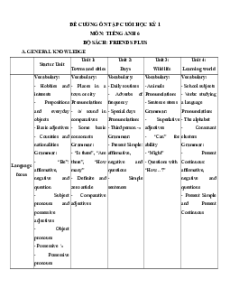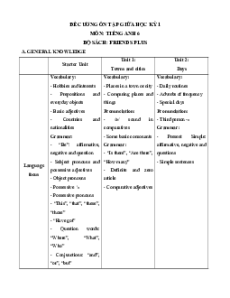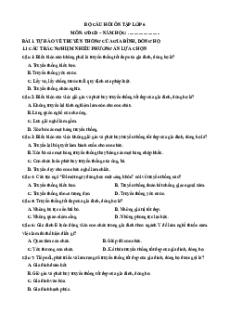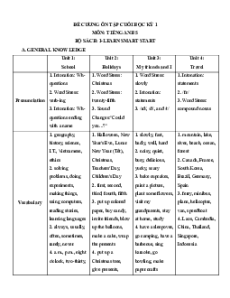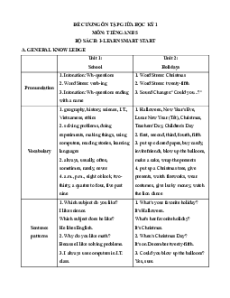Date of planning:………
Peroid 79 :UNIT 10: OUR HOUSES IN THE FUTURE
Date of teaching: ………
Lesson 1: GETTING STARTED WEEK: MY FUTURE HOUSE
THIS UNIT INCLUDES: Vocabulary Skills:
- Types of houses and appliances in the house - Reading about houses and appliances in the Pronunciation: future
- Stress in two-syllable words.
- Talking about different houses in the future. Grammar
- Listening to about dream houses - Future simple.
- Writing a paragraph about dream house
- Might for future possibility Everyday English Expressing surprise I. OBJECTIVES:
* By the end of this unit, students will be able to:
- use the words related to types of houses and appliances in the house;
- pronounce the two-syllable words correctly;
- use future simple and might for future possibility; expressing surprise;
- read for specific information about houses and appliances in the future;
- talk about different houses in the future;
- listen for specific information about dream houses;
- write a paragraph about a dream house. 1. Knowledge:
- To introduce topic of the lesson houses and appliances in the house. To teach listening and reading about future house.
+ Vocabulary: Using the words related to types of houses and appliances in the house;
- Stress in the two-syllable words;
+ Grammar: - The usage of future simple and might for future possibility; expressing surprise;
2. Competence: By the end of the lesson students will be able to pratice reading and listening the
conversation between Nick and Phong about Phong’s house in the future.
3. Quality/ behavior : The love of their own houses and appliances in the house. Having serious
attitude to imagining the houses in the future ; Having serious attitude to working in groups,
individual work, cooperative learning and working. II. TEACHING AIDS:
- Teacher: Text book, laptop, louspeaker, projector…
- Students : Text books, studying equipments….
- Work Arrangements: T_Ss , group works; individual …… III. PROCEDURE:
I. WARM UP & INTRODUCTION (5’) Aims:
- To create an active atmosphere in the class before the lesson; - To lead into the new unit.
* Content: Review the previous lesson . Brainstorm the types of houses .
* Outcome: Having a chance to speak English and focus on the topic of the lesson..
* Organisation :Teacher’s instructions…
Teacher’s & Student’s activities Content + Greeting + Greeting + Brainstorming + T_ Ss
- Teacher (T) asks Ss some questions about the building previous lessons,
- T may introduce some warm-up activities to creat
a friendly and relaxed atmostphere to inspire Ss to
warm up to the subject and new class… Types of houses
- T encourages Ss to brainstorm the types of houses
they have known. Elicit from Ss.
+ Lead to the first unit of the new school year.
- Write the title of the unit Houses in the Future on cottages
the board. Have Ss say something about the houses
they are living in and the furniture or appliances they have got.
- (Ss) listen and learn how to do it .
- Tell them to think about the houses and
appliances they want in the future.
- Open their book and write .
2. PRESENTATION (12’) ACTIVITY 1:
Aims: - To set the context for the introductory text;
- To introduce the topic of the unit.
* Content: Listen and read conversation to get used to the vocabulary; new grammar points.
* Outcome: Reading practice. Finding out new words; Ss soon become familiar with the new language items.
* Organisation : Teacher’s instructions…
1. Listen and read. T_ Ss 1. Listen and read.
*) Pre- teach vocabulary: * Vocabulary
- Teacher uses different techniques to teach - UFO (Unidentified Flying Object)
vocabulary (situation, realia, translation .....)
- solar energy (n) năng lượng măt trời
+ Teacher may introduce the vocabulary by:
- appliance (n) thiết bị
- providing explanations of the words;
- smart (adj) thông minh
- showing picture illustrating the word.
- ocean (n) đại dương
+ Follow the steps to teach vocabulary
- Repeat in chorus and individually
- beach (n) biển + Check vocabulary
- sky (n) bầu trời
* Have Ss look at the picture. Have them answer
some questions, e.g. Who are they? What is Phong
doing? What are they talking about?
- Focus on some main information about the
conversation (They are Phong and Nick. Phong is
painting a UFO. They are talking about Phong's house in the future.).
- Play the recording for Ss to listen to the whole conversation once.
- Play the recording again, sentence by sentence,
for them to listen and repeat. Have them listen and
repeat the conversation more than once, if
necessary, until they feel confident.
- Have Ss read the conversation in pairs.
- Draw Ss' attention to the uses of will (for future)
and might (for future possibility) by underlining the
sentences with will and might.
- Go around and offer help if necessary.
- Get some pairs to read the conversation in front of * Answer the teacher’s questions. the class.
- Find out the words related to the topic.
- Check their pronunciation, if necessary. - Complete the tasks 3. PRACTICE (18’) ACTIVITY 2:
Aim: To help Ss understand the conversation.
* Content: Read again the conversation write down the words or phrases.
* Outcome: Ss get more information and undertand more the conversation.
* Organisation : Teacher’s instructions…
2. Read the conversation again. Find and write
2. Read the conversation again. Find and
down the words or phrases…
write down the words or phrases…
- Write on the board Type of house, Location and - T_ Ss
Appliances in the house. Explain the meaning of
- Follow the teacher’s instructions
the words: type, location and appliances. Have - Give the answers and check.
them listen and repeat the words several times.
- Work in groups, have Ss read the conversation
again and find the words or phrases to show type of
the house, the location of the house and its
appliances. Then have some Ss say the words and
phrases in front ofthe class. Explain UFO (Unidentified Flying Object) if Ss do not know.
If there is enough time, ask one student to go to the
board and write the words / phrases. * Key:
- Check the answers as a class. - Type of house: UFO - Location: in the mountains
- Appliances in the house: some smart TVs and ten robots ACTIVITY 3:
Aim: To help Ss read for specific information about the house and appliances in the house.
* Content: : Read again the conversation and tick T/ F.
* Outcome: Ss get more information and undertand more about the house and appliances.
* Organisation : Teacher’s instructions…
3. Read the conversation again and tick (✓) T
3. Read the conversation again and tick (True) or F (False).
(✓) T (True) or F (False).
- Give time for Ss to read the conversation - T_ Ss
independently again and tick (✓) true or false next - Learn how to do it to the statements. - Share the answers
- Ask them to share their answers in pairs before - Copy them discussing in groups.
- Encourage them to correct the false statements.
- Select one student to give his or her answers in Key: front of the class.
1. T 2. T 3. T 4. F
- Praise them when they give the correct answers.
- Ss share their answers and discuss.
- Check their answers as a class.
- Write the correct answers on the board. - T gives correct answer ACTIVITY 4:
Aim : To help Ss make phrases about places.
* Content: Order the words to make a phrase about a place.
* Outcome: Ss cam make sentneces using the given words/ phrases.
* Organisation : Teacher’s instructions…
4. Order the words to make a phrase about
4. Order the words to make a phrase
places. Each group has one extra word.
about places. Each group has one extra
- Explain that Ss have to order the words to make word.
phrases about places. Remind them that each group - T_ Ss has one extra word. - Group works
- Get them to look at the example to Identify how
- Ss do themselves. Give the answers to do the activity.
- Have Ss work Individually. Ask them to share
their answers In pairs before discussing it Key:
- In groups. Go around and offer help If necessary. 1. in the sea
- Then call on some Ss to write their answers on the 2. in the city
board. Check their answers and give explanation if 3. in the town necessary. 4. in the mountains
- Allow them to discuss in pairs or groups. 5. in the countryside
- Check the answers as a class. 6. on the Moon 7. in the sky
4. PRODUCTION/ FURTHER PRACTICE (8’) ACTIVITY 5:
Aim : To help Ss listen and guess the location of houses in the future from the description.
* Content: To describe to the classmates the future house. Guess where the house is
* Outcome: Ss can describe to the classmates the future house. Other students guess the location of houses.
Giáo án Unit 10: Our houses in the future Tiếng Anh 6 Global success
710
355 lượt tải
MUA NGAY ĐỂ XEM TOÀN BỘ TÀI LIỆU
CÁCH MUA:
- B1: Gửi phí vào TK:
1133836868- CT TNHH DAU TU VA DV GD VIETJACK - Ngân hàng MB (QR) - B2: Nhắn tin tới Zalo VietJack Official ( nhấn vào đây ) để xác nhận thanh toán và tải tài liệu - giáo án
Liên hệ ngay Hotline hỗ trợ: 084 283 45 85
Bộ giáo án Tiếng anh 6 Global success được cập nhật liên tục trong gói này từ nay đến hết tháng 3/2024.
Để tải tài liệu gốc về máy bạn click vào nút Tải Xuống ở trên!
Thuộc bộ (mua theo bộ để tiết kiệm hơn):
- Bộ giáo án Tiếng anh 6 Global success năm 2023 mới, chuẩn nhất được thiết kế theo phong cách hiện đại, đẹp mắt, trình bày chi tiết cho từng bài học và bám sát chương trình Sách giáo khoa Tiếng anh 6 Global success.
- Mua trọn bộ sẽ tiết kiệm hơn tải lẻ 50%.
Đánh giá
4.6 / 5(710 )5
4
3
2
1
Trọng Bình
Tài liệu hay
Giúp ích cho tôi rất nhiều
Duy Trần
Tài liệu chuẩn
Rất thích tài liệu bên VJ soạn (bám sát chương trình dạy)
TÀI LIỆU BỘ BÁN CHẠY MÔN Tiếng Anh
Xem thêmTÀI LIỆU BỘ BÁN CHẠY Lớp 6
Xem thêmTài liệu bộ mới nhất

Date of planning:………
Date of teaching: ………
WEEK:
Peroid 79 :UNIT 10: OUR HOUSES IN THE FUTURE
Lesson 1: GETTING STARTED
MY FUTURE HOUSE
THIS UNIT INCLUDES:
Vocabulary
- Types of houses and appliances in the house
Pronunciation:
- Stress in two-syllable words.
Grammar
- Future simple.
- Might for future possibility
Skills:
- Reading about houses and appliances in the
future
- Talking about different houses in the future.
- Listening to about dream houses
- Writing a paragraph about dream house
Everyday English
Expressing surprise
I. OBJECTIVES:
* By the end of this unit, students will be able to:
- use the words related to types of houses and appliances in the house;
- pronounce the two-syllable words correctly;
- use future simple and might for future possibility; expressing surprise;
- read for specific information about houses and appliances in the future;
- talk about different houses in the future;
- listen for specific information about dream houses;
- write a paragraph about a dream house.
1. Knowledge:
- To introduce topic of the lesson houses and appliances in the house. To teach listening and reading
about future house.
+ Vocabulary: Using the words related to types of houses and appliances in the house;
- Stress in the two-syllable words;
+ Grammar: - The usage of future simple and might for future possibility; expressing surprise;
2. Competence: By the end of the lesson students will be able to pratice reading and listening the
conversation between Nick and Phong about Phong’s house in the future.
3. Quality/ behavior : The love of their own houses and appliances in the house. Having serious
attitude to imagining the houses in the future ; Having serious attitude to working in groups,
individual work, cooperative learning and working.
II. TEACHING AIDS:
- Teacher: Text book, laptop, louspeaker, projector…
- Students : Text books, studying equipments….
- Work Arrangements: T_Ss , group works; individual ……
III. PROCEDURE:
I. WARM UP & INTRODUCTION (5’)
Aims:
- To create an active atmosphere in the class before the lesson;
- To lead into the new unit.
* Content: Review the previous lesson . Brainstorm the types of houses .
* Outcome: Having a chance to speak English and focus on the topic of the lesson..

* Organisation :Teacher’s instructions…
Teacher’s & Student’s activities
Content
+ Greeting
+ Brainstorming
- Teacher (T) asks Ss some questions about the
previous lessons,
- T may introduce some warm-up activities to creat
a friendly and relaxed atmostphere to inspire Ss to
warm up to the subject and new class…
- T encourages Ss to brainstorm the types of houses
they have known. Elicit from Ss.
+ Lead to the first unit of the new school year.
- Write the title of the unit Houses in the Future on
the board. Have Ss say something about the houses
they are living in and the furniture or appliances
they have got.
- Tell them to think about the houses and
appliances they want in the future.
+ Greeting
+ T_ Ss
- (Ss) listen and learn how to do it .
- Open their book and write .
2. PRESENTATION (12’)
ACTIVITY 1:
Aims: - To set the context for the introductory text;
- To introduce the topic of the unit.
* Content: Listen and read conversation to get used to the vocabulary; new grammar points.
* Outcome: Reading practice. Finding out new words; Ss soon become familiar with the new
language items.
* Organisation : Teacher’s instructions…
1. Listen and read. T_ Ss
*) Pre- teach vocabulary:
- Teacher uses different techniques to teach
vocabulary (situation, realia, translation .....)
+ Teacher may introduce the vocabulary by:
- providing explanations of the words;
- showing picture illustrating the word.
+ Follow the steps to teach vocabulary
- Repeat in chorus and individually
+ Check vocabulary
* Have Ss look at the picture. Have them answer
some questions, e.g. Who are they? What is Phong
doing? What are they talking about?
- Focus on some main information about the
conversation (They are Phong and Nick. Phong is
painting a UFO. They are talking about Phong's
house in the future.).
- Play the recording for Ss to listen to the whole
1. Listen and read.
* Vocabulary
- UFO (Unidentified Flying Object)
- solar energy (n) năng lượng măt trời
- appliance (n) thiết bị
- smart (adj) thông minh
- ocean (n) đại dương
- beach (n) biển
- sky (n) bầu trời
Types of houses
building
cottages

conversation once.
- Play the recording again, sentence by sentence,
for them to listen and repeat. Have them listen and
repeat the conversation more than once, if
necessary, until they feel confident.
- Have Ss read the conversation in pairs.
- Draw Ss' attention to the uses of will (for future)
and might (for future possibility) by underlining the
sentences with will and might.
- Go around and offer help if necessary.
- Get some pairs to read the conversation in front of
the class.
- Check their pronunciation, if necessary.
* Answer the teacher’s questions.
- Find out the words related to the topic.
- Complete the tasks
3. PRACTICE (18’)
ACTIVITY 2:
Aim: To help Ss understand the conversation.
* Content: Read again the conversation write down the words or phrases.
* Outcome: Ss get more information and undertand more the conversation.
* Organisation : Teacher’s instructions…
2. Read the conversation again. Find and write
down the words or phrases…
- Write on the board Type of house, Location and
Appliances in the house. Explain the meaning of
the words: type, location and appliances. Have
them listen and repeat the words several times.
- Work in groups, have Ss read the conversation
again and find the words or phrases to show type of
the house, the location of the house and its
appliances. Then have some Ss say the words and
phrases in front ofthe class. Explain UFO
(Unidentified Flying Object)
if Ss do not know.
If there is enough time, ask one student to go to the
board and write the words / phrases.
- Check the answers as a class.
2. Read the conversation again. Find and
write down the words or phrases…
- T_ Ss
- Follow the teacher’s instructions
- Give the answers and check.
* Key:
- Type of house: UFO
- Location: in the mountains
- Appliances in the house: some smart TVs
and ten robots
ACTIVITY 3:
Aim: To help Ss read for specific information about the house and appliances in the house.

* Content: : Read again the conversation and tick T/ F.
* Outcome: Ss get more information and undertand more about the house and appliances.
* Organisation : Teacher’s instructions…
3. Read the conversation again and tick (✓) T
(True) or F (False).
- Give time for Ss to read the conversation
independently again and tick (✓) true or false next
to the statements.
- Ask them to share their answers in pairs before
discussing in groups.
- Encourage them to correct the false statements.
- Select one student to give his or her answers in
front of the class.
- Praise them when they give the correct answers.
- Ss share their answers and discuss.
- Check their answers as a class.
- Write the correct answers on the board.
- T gives correct answer
3. Read the conversation again and tick
(✓) T (True) or F (False).
- T_ Ss
- Learn how to do it
- Share the answers
- Copy them
Key:
1. T 2. T 3. T 4. F
ACTIVITY 4:
Aim : To help Ss make phrases about places.
* Content: Order the words to make a phrase about a place.
* Outcome: Ss cam make sentneces using the given words/ phrases.
* Organisation : Teacher’s instructions…
4. Order the words to make a phrase about
places. Each group has one extra word.
- Explain that Ss have to order the words to make
phrases about places. Remind them that each group
has one extra word.
- Get them to look at the example to Identify how
to do the activity.
- Have Ss work Individually. Ask them to share
their answers In pairs before discussing it
- In groups. Go around and offer help If necessary.
- Then call on some Ss to write their answers on the
board. Check their answers and give explanation if
necessary.
- Allow them to discuss in pairs or groups.
- Check the answers as a class.
4. Order the words to make a phrase
about places. Each group has one extra
word.
- T_ Ss
- Group works
- Ss do themselves. Give the answers
Key:
1. in the sea
2. in the city
3. in the town
4. in the mountains
5. in the countryside
6. on the Moon
7. in the sky
4. PRODUCTION/ FURTHER PRACTICE (8’)
ACTIVITY 5:
Aim : To help Ss listen and guess the location of houses in the future from the description.
* Content: To describe to the classmates the future house. Guess where the house is
* Outcome: Ss can describe to the classmates the future house. Other students guess the location of
houses.

* Organisation : Teacher’s instructions…
5. In group, describe to your classmates what
you can see outside the window of your future
house.
- First, ask Ss to read the example and explain how
the task is carried out: Ss work in groups. One
group member describes to his / her group what he /
she can see outside the window of his / her future
house. The other group members try to guess where
his / her house is.
- Before doing the task, ask one pair of Ss to read
aloud the exchange in the example as a model.
- Give Ss time to do the task In groups.Then call on
some groups to perform the task In front of the
class. Ask the class to listen and comment.
- This activity can be organized as a competitive
game. The class is divided into teams A and B.
Team A describes and Team B tries to guess. If the
guess is correct, they get one point. Then change
roles. The group with the most points is the winner.
- Show the winner.
5. In group, describe to your classmates
what you can see outside the window of
your future house.
- Work in two teams
- Do the tasks
Eg :
A. outside my window I can see the beach
and the water.Where’s my house?
B. It’s in the sea.
A. Correct.
5 . WRAP-UP & HOME WORK (2’)
* Ask one or two Ss to tell the class what they have learnt.
- Ask Ss to say aloud some words they remember from the lesson.
* HOME WORK
- Read again the conversation on page 26
- Do more exercises in workbook.
- Prepare new lessons
=====================
